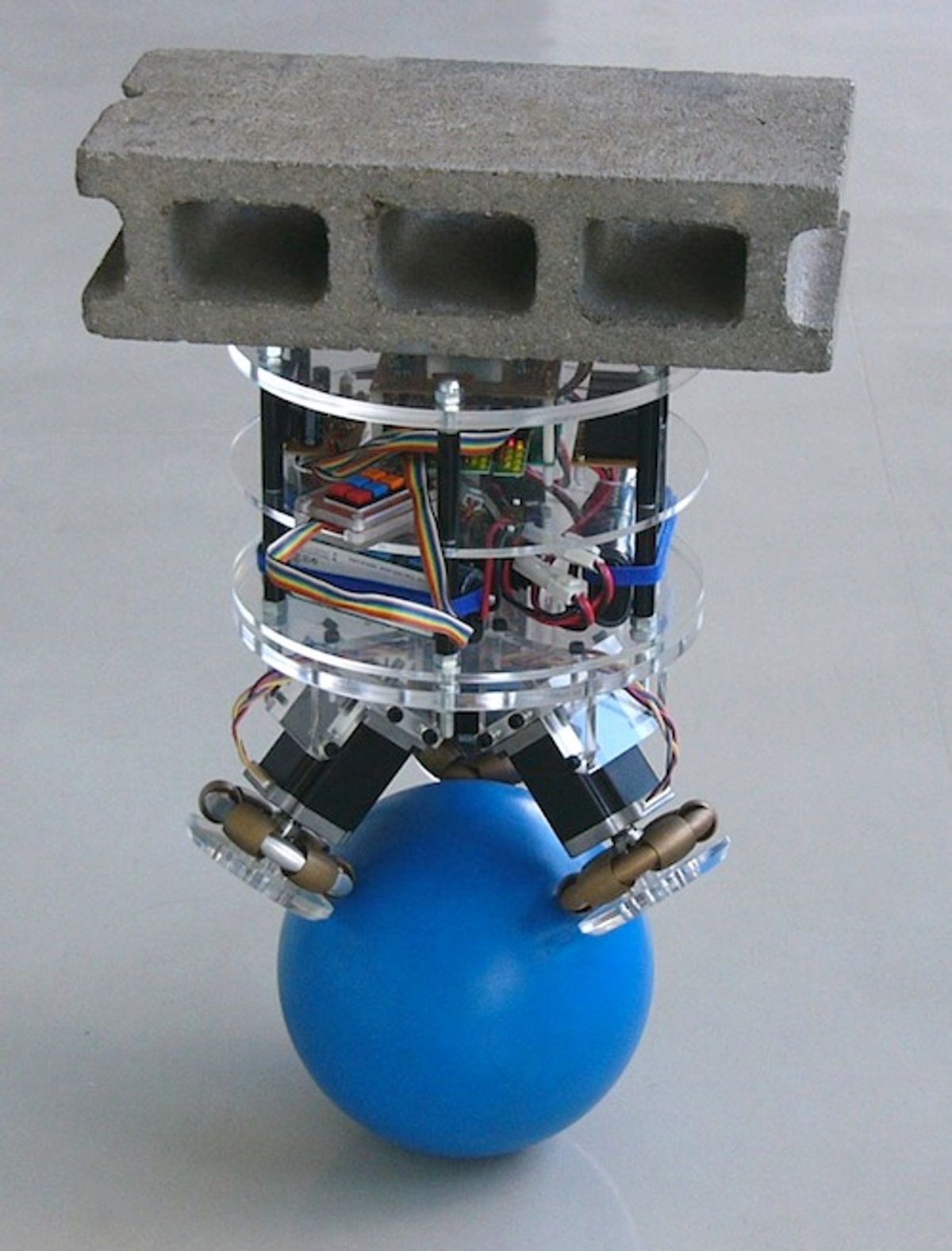Dr. Masaaki Kumagai, director of the Robot Development Engineering Laboratory at Tohoku Gakuin University, in Tagajo City, Japan, has built wheeled robots, crawling robots, quadruped robots, biped robots, and biped robots on roller skates.
Then one day a student suggested they build a robot that would balance on a ball.
Dr. Kumagai thought it was a wonderful idea.
The robot they built rides on a rubber-coated bowling ball, which is driven by three omnidirectional wheels. The robot can not only stand still but also move in any direction and pivot around its vertical axis.
It can work as a mobile tray to transport cocktails objects and it can also serve as an omnidirectional supporting platform to help people carry heavy objects.
Such a ball-balancing design is like an inverted pendulum, and thus naturally unstable, but it offers advantages: it has a small footprint and can move in any direction without changing its orientation.
In other words, whereas a two-wheel self-balancing robot has to turn before it can drive in a different direction, a ball-riding robot can promptly drive in any direction. Try that, Segway!
Dr. Kumagai and student Takaya Ochiai built three robots and tested them with 10-kilogram bricks. They even made them work together to carry a large wooden frame.
Watch:
The robot is about half meter high and weighs 7.5 kg. The ball is a 3.6-kg bowling ball with a 20 centimeter diameter and coated with rubber spray.
Its ball driving mechanism uses three omnidirectional wheels developed at Japan’s R&D institute RIKEN.
To power the wheels, they chose NIDEC motors and micro-step controllers to achieve a rate of 0.225 degree per step, which made the rotation of the wheels smooth.
The robot's control system runs on a 16-bit microcontroller, which receives data from two sets of Analog Devices gyroscopes and accelerometers.
It’s interesting that they had to use both gyros and accelerometers. The gyros can detect fast movements, or high-frequency components, but they’re not suited when you want to derive the inclination of the robot. On the other hand, the accelerometers can detect the inclination but they're affected by the motion of the robot, so they couldn't be used alone.
The control strategy is the same used for other inverted pendulum-type systems. The goal of the control system is to keep the inclination at zero degrees and keep the ball on the same spot. If you push the robot, it will try to balance itself and return to the original location.
The idea of ball-balancing robots and one-wheeled robots dates back to the 1970s. Today even hobbyists have shown off cool designs, and a few large-scale robots have been built in academia. Perhaps the most famous is Ballbot, developed by researchers at Carnegie Mellon. It’s a dynamically stable mobile robot that is tall enough to interact with people. (Watch videos here.)
Dr. Kumagai’s robot added some new tricks, including something other ball-bots cannot do: thanks to its innovative omnidirectional wheel driving system, it can rotate around its vertical axis.
The robot has two control modes. The first tries to keep the robot stable and on the same spot, as described above. The other is a passive mode, in which the robot remains stable but you can easily push it around, even using just a finger [photo, right].
What’s next? Dr. Kumagai wants to make the robot more user-friendly for carrying things and he plans to combine several of them in cooperative behaviors.
Update from Dr. Kumagai: “A month ago, the robot was named BallIP, short for Ball Inverted Pendulum. In addition, Mr. Takaya Ochiai finished his master course at Tohoku Gakuin this March—and he got a job!”
More photos:
Images and video: Dr. Masaaki Kumagai/Tohoku Gakuin University
Erico Guizzo is the Director of Digital Innovation at IEEE Spectrum, and cofounder of the IEEE Robots Guide, an award-winning interactive site about robotics. He oversees the operation, integration, and new feature development for all digital properties and platforms, including the Spectrum website, newsletters, CMS, editorial workflow systems, and analytics and AI tools. An IEEE Member, he is an electrical engineer by training and has a master’s degree in science writing from MIT.









